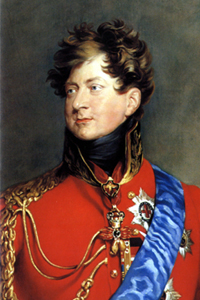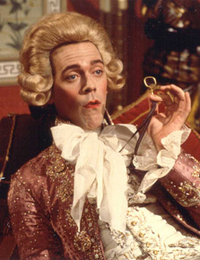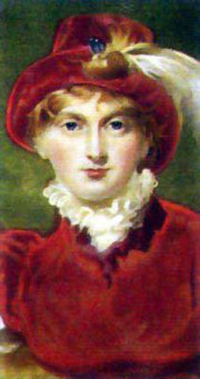
2 PENCE COIN - GREAT BRITAIN - GEORGE IV (MAUNDY)
(KM 684)
Date: A.D. 1823
Obverse: Portrait laureate head left - GEORGIUS IIII D.G. BRITANNIAR REX F D
Reverse: Wreath and crown over denomination - 2 1823
Engraver Obv: Benedetto Pistrucci
Engraver Rev: Jean Baptiste Merlen
Hugh Laurie plays Prince George in the BBC comedy Black Adder as a clueless spoiled royal twit
One of many unflattering contemporary cartoons depicting a corpulent George IV
Caroline of Brunswick: Consort of King George IV |
GEORGIUS IIII D[ei] G[ratia] BRITANNIAR REX F[idei] D[efensor] Maundy Thursday is an ancient ceremony celebrated by many Christians in Great Britain though similar ceremonies are conducted all over the world under various different names. The Maundy ceremony commemorates the Last Supper and has its origin in the commandment Christ gave after washing the feet of his disciples on the day before Good Friday "A new commandment I give unto you, That ye love one another; as I have loved you" John (13:34) In the United Kingdom these ceremonies have included the reigning Monarch offering "alms" to deserving poor and senior citizens. This practice seems to have started as early as the thirteenth century when members of the royal family took part in Maundy ceremonies by distributing money and gifts, and to emulate Christ's act of humility by washing the feet of the poor. King Edward II is the first monarch to have been recorded actively taking part in the ceremony, although its origins are probably quite a bit earlier as King John is said to have taken part in a ceremony in about 1210 donating small silver coins to the poor. King Edward III washed feet and gave gifts including money to the poor though the act of washing the feet was eventually discontinued, the last Monarch to do so was James II. The minting and issuance of Maundy money started in the reign of Charles II with an undated issue of hammered coins in 1662. The coins were a four penny, three penny, two penny and one penny piece but it was not until 1670 that a dated set of all four coins appeared. Prior to this, ordinary coinage was used for Maundy gifts. In modern Maundy ceremonies money alone is given instead of other gifts of food and clothing. Today the sovereign hands to each recipient one red purse and one white purse. The red containing ordinary coinage in lieu of food and clothing; The white containing silver Maundy coins consisting of the same number of pence as the years of the sovereign's age, a practice which began with King Henry IV. Although Maundy money is minted in Sterling (0.925) silver all Maundy money remains legal tender in Britain. King George IV of England: George Augustus Frederick was born at St James's Palace, London on August 12, 1762 and was the eldest son of 15 children born to King George III and Queen Charlotte of the House of Hanover. In his youth George, the Prince of Wales, is said to have been a bright and a talented student having quickly learned to speak French, German and Italian in addition to his native English. By his teens, George had already begun to exhibit rebellious tendencies. When The Prince of Wales turned 21 in 1783 he obtained a grant of £60,000 from Parliament and an annual income of £50,000 from his father, he established his residence in Carlton House and began in earnest a life of luxury, decadence, and excess. A rift developed between him and his frugal, conservative, Tory father who disapproved of his his extravagant lifestyle, affairs with women, and his radically-inclined Whig politician friends such as Charles Fox and Richard Sheridan. In 1784 he fell in love with, and married, the widow Maria Anne Fitzherbert. The marriage was kept a secret as under the terms of the Royal Marriages Act of 1772, it was illegal for a member of the royal family to marry a Roman Catholic or marry without the kings consent. Such a marriage would make the prince ineligible to succeed his father to the throne. By the 1780s the Prince of Wales had become a gambler, a womanizer, and a heavy drinker. He was deeply in debt and when Parliament agreed to increase his allowance, his father remarked that it was "a shameful squandering of public money to gratify the passions of an ill-advised young man." The Prince continued his exorbitant lifestyle undeterred and by 1795 his debts totaled in excess of £650,000. His father refused to help him so he instead agreed to marry his cousin, Caroline of Brunswick, in exchange for debt relief. The prince and his new bride seemed to have a mutual distaste for each other. The Prince regarded Caroline as unattractive and unhygienic; he also suspected that she was not a virgin when they married. She found him equally unattractive, and the prince's correspondence reveals that the couple only had sexual intercourse three times during their marriage, twice during the first night, and once the second night. After the birth of their only child, Princess Charlotte, in 1796, they choose to live separately. The Prince would continue to be involved with Mrs. Fitzherbert among others until his death while Caroline would become involved in various affairs. Both are thought to have had illegitimate children with other lovers. King George III fell ill, possibly suffering from the hereditary disease porphyria resulting in abdominal pain, vomiting, acute neuropathy, seizures, and mental disturbances, including hallucinations, depression, anxiety, and paranoia. As a result there were long periods of time in which he was unable to exercise his royal duties. After a time it seemed the King had recovered from his prolonged illness and would remain on the throne but after a final bout following the death of his youngest daughter, Princess Amelia, Parliament (after much debate) passed the Regency Act of 1811 and the Prince of Wales was appointed regent on the January 5th of that year and would serve as regent for the next nine years until his fathers death in 1820. Previously the prince had been a proponent of catholic emancipation, something supported by the Whigs and opposed by the Tories, but once in power George changed his views and became a strong opponent of Catholic Emancipation. He also abandoned his support for those Whigs who were arguing for parliamentary reform. During this time the parliament was split, neither side wishing to cooperate with other while the Prince urged bipartisan cooperation and power sharing leading to a tumultuous highly partisan political rift. One possible reason for his failure to support the Whigs whom he had earlier supported was the fact that the Tories were the driving force pushing to continue and win the war in Europe against the aggressive French Emperor Napoleon I. In 1814 an allied force made up of Russia, Prussia, Austria, the United Kingdom and several smaller countries defeated Napoleon. Napoleon makes his historic return in 1815 only to be defeated in the end at the Battle of Waterloo by Arthur Wellesley, 1st Duke of Wellington. Also in this year the British-American War of 1812 concluded without a decisive victory for either side. During this time the prince, along with associates such as the dandy Beau Brummell and the architect John Nash, created the Regency style. The Prince of Wales was greatly interested in matters of style and was impressed by the work of the architect John Nash. He commissioned him to design Regent's Park, arranged for Nash to create Buckingham Palace out of Buckingham House, and the reshaping of the Royal Pavilion at Brighton into a extravagant grande seaside palace in Oriental theme inspired loosely by the Taj Mahal. On the death of his father in 1820 George became king. His estranged wife Caroline had earlier left the United Kingdom for Europe, where she is reported to have indulged in all forms of scandalous behavior. Upon hearing of the death of King George III she chose to return to England to claim her rights as Queen. George first sought a divorce but when it was suggested that any divorce proceeding might lead to his own questionable behavior being revealed, he instead persuaded Lord Liverpool and his government to propose an Act of parliament, the Pains and Penalties Bill, to deprive her of the title Queen and to declare the marriage "for ever wholly dissolved, annulled and made void". The Whigs opposed the measure as did he general public, who favored Caroline and there were public demonstrations against the new king. On the day of the coronation, Caroline made an attempt to attend but was turned away at the doors of Westminster Abbey on orders of the new king which resulted resulted in further public demonstrations. The situation was resolved soon afterwards when Caroline died suddenly on August 7, 1821. It is reported that during her illness she stated that she thought she had been poisoned. George's coronation was, like his lifestyle, extravagant and expensive costing roughly £243,000 as compared to his fathers coronation which cost a mere £10,000. In 1821 the King became the first monarch to pay a state visit to Ireland since Richard II and he visited Edinburgh the following year. His visit to Scotland was the first by a reigning British monarch since Charles I in 1633. His earlier support for catholic emancipation was a thing of the past. He launched a private anti-Catholic campaigned against the Catholic Relief Bill of 1813 which was ultimately defeated. By 1824 he was denouncing Catholic emancipation in public. He argued that he had sworn to uphold the Protestant faith when he became King and could not support any pro-Catholic measures. The Duke of Wellington, with great difficulty, obtained the King's begrudging consent to the introduction of a Catholic Relief Bill in 1829 but the king later withdrew his consent under pressure from his fanatically anti-Catholic brother, the Duke of Cumberland. In protest the Cabinet resigned and on the following day the King, now under intense political pressure, reluctantly agreed to the Bill. George's indulgent lifestyle seriously damaged his health. By the 1820s he was extremely overweight and was addicted to both alcohol and laudanum. His obesity, gluttony and heavy drinking increasingly made him the target of ridicule on the rare occasions he appeared in public. He suffered from gout, arteriosclerosis, cataracts and possibly suffered from porphyria, the same hereditary illness that plagued his father. He began showing signs of insanity, reportedly telling people that he had been a soldier and had fought at the Battle of Waterloo. In the end the king became more and more a recluse at Windsor Castle spending much of his time in bed. George IV died on June 26, 1830 at Windsor Castle. he is said to have grabbed his page's hand exclaiming "Good God, what is this? my boy, this is death." After his death one newspaper stated: 'There never was an individual less regretted by his fellow-creatures than this deceased king. What eye has wept for him? What heart has heaved one throb of unmercenary sorrow? ... If he ever had a friend — a devoted friend in any rank of life — we protest that the name of him or her never reached us' Of King George IV the Duke of Wellington had earlier stated: "(he is) the worst man I ever fell in with my whole life, the most selfish, the most false, the most ill-natured, the most entirely without one redeeming quality" Although in his eulogy of the king he praised his knowledge and talent calling him "the most accomplished man of his age." in an even later statement he says George was: "a magnificent patron of the arts...the most extraordinary compound of talent, wit, buffoonery, obstinacy, and good feeling — in short a medley of the most opposite qualities, with a great preponderance of good — that I ever saw in any character in my life." King George IV left no heir as his only daughter, Princess Charlotte Augusta of Wales, had died in 1817 after giving birth to a still born son. He was succeeded by his brother, Prince William, Duke of Clarence, who reigned as William IV.
|







